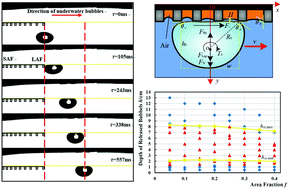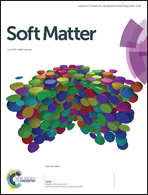Self-transport of underwater bubbles on a microholed hydrophobic surface with gradient wettability†
Abstract
Manipulation of underwater bubbles is of great importance in both scientific research and industrial applications. In this work, the motion of underwater bubbles on a microholed polydimethylsiloxane (PDMS) surface with gradient wettability is studied using a high-speed camera. It was found that underwater bubbles self-transported directionally from the smaller area fraction (SAF) to the larger area fraction (LAF) of the surface. Besides, the bubble motion was triggered by an effective depth range from hcr,min to hcr,max. Only the depth of the bubble was within the range when the self-transport motion occurred. Otherwise the bubble would adhere onto the surface eventually. The main cause for the motion is the trapped air inside the microholes, which generates the torque Tb and the retention force Fr driving the bubble directionally. The mathematical model is established to reveal the motion mechanism, which is verified by the experimental results. The outcomes of our work shed new light on the target transportation fields such as drug delivery and submarine gas collection.



 Please wait while we load your content...
Please wait while we load your content...